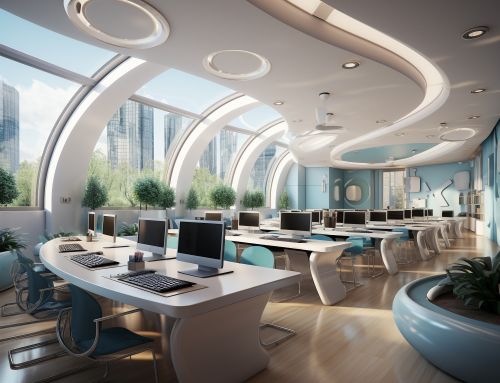An office’s purpose is to create a comfortable and safe working environment that encourages people to collaborate and be productive. It can be a challenge — but fear not, smart office IoT technology is up to the task.
Here’s how repurposing smart home strategies along with a security infrastructure can save your workers’ time and efforts on daily tasks like managing spaces, visitors and assets.
Multi-location office management
Even though office management through security cameras and electronic badges us not considered that innovative, there are ways IoT development can enhance it.
For example, you can always know what happens in any of your offices across the world in real time — by using computer vision-enabled cameras, motion sensors, and other multipurpose trackers. They track all the activities inside during open hours and keep a record of arriving deliveries, as well as visitors. All data is available for viewing in a single interface that supports your PC or smartphone.
Such a system of interconnected touchpoints enables you to make informed decisions on the go. It raises your awareness regarding pending office management issues like lack of supplies, unplanned visitors or broken inventory. Even if you are away on vacation, you can deal with it immediately —- be it a motion detector capturing unusual activity at night, or a smart coffee machine running out of beans.
Employee onboarding
Another daily office task that frequently requires personal presence is welcoming newcomers. Usually, everything they need to know about their workplace may be put onto a web page or in a mobile app. An obligatory guided tour can also become self-sustained.
To enable up-to-date info and navigation capabilities, a geofencing or a beacon-based hardware solution can be used. Both solutions create a connected environment around the office, using Wi-Fi or Bluetooth to transmit data.
When passing by a kitchen area for the first time, for instance, a new employee receives a push notification indicating it. If there is a need to find a colleague in a huge open space, there will be a seating map with a real-time navigated route.
Later, an employee continues to benefit from IoT-driven office: the hardware picks up location and personnel changes instantly, and the collected data always stays relevant, saving time on search.
Room booking, availability, and management
IoT enhances meeting planning and schedule visibility by making conference rooms smart. It means that employees can schedule a meeting in the most suitable room remotely, book the equipment required, and confirm one’s presence or absence — all without a verbal agreement. For managers, it means seeing and monitoring rooms availability and equipment workload in real time.
Such connectivity can be achieved with lights, motion, and energy consumption sensors. They send a signal with their current status to a cloud server once in a while — reporting light and motion intensity, computer’s usage, etc. Then, this signal is decoded, and the info about people present is displayed on the scheduling panel. It prevents double-booking and collects historical data for usage analysis.
In the long run, this technology can help in energy saving and predictive maintenance of the meeting room assets. Detailed statistics on how and when employees use rooms and corporate AV devices serves as a guide for future investments in office upgrading.
Restricted access and control
If there is a need for advanced security and employee-only access on-premises, like in a banking or a military facility, there are IoT solutions that don’t interfere with the workflow. For secure authentication in the restricted areas, there are biometric-based methods involving fingerprints, retina, voice and face recognition.
Inside the office corridors, there might be full HD cameras that capture people’s faces, and a processing system that sorts out regulars from visitors. Similar technology can be applied to solve parking lot issues outside: sensors determine free and taken spots, and who uses them.
All these locations, including their door transit counts and alarm controls, can be added to the same IoT ecosystem. Thanks to on-the-fly video streaming possible in the cloud, such a system monitors multiple security cam streams at once —- and can automatically deny or request access, based on 99%-accurate face recognition.
The moderation of the system is available to facility managers through a unified platform. All data streams get analyzed, visualized into statistics, and complemented with options. For an instant
Well-being: lighting and climate control
To make the daily life of your employees more comfortable and prevent disputes and complaints, IoT offers precise control over mechanisms and electric appliances around the office. One can open a window to a certain degree, or dim the lights simply by a tap on a screen, without leaving one’s chair.
Most kitchen and home appliances like air conditioners, fridges, humidifiers, lamps already come in a ‘smart’ form and can be connected to the apps via Bluetooth or Wi-Fi. Window and door locks require installing hardware like beacons or sensors to track their position in space.
As well as for security monitoring, all of those office items can be aligned in the same metrics dashboard. From there, any user can set time periods for daily ventilation, or make sure all office doors are locked after 5 PM.
The second benefit of smart office after comfort is smart consumption. Office managers can put devices in sleep mode at night, prepare the office in the morning by adjusting temperature and CO2 levels, and checking battery levels in electronics. These procedures result in cut costs on excessive use of electricity, water and heating, and of course, happy and productive workers.
IoT makes your office self-sustained
Smart IoT-driven office means more time for business and less for office-keeping chores and bureaucratic procedures like ordering maintenance. Your employees get distracted less and save time on organizing their workspace.
Smart office IoT systems are totally scalable and modular. They may include any number of trackable parameters in any combinations to deal with day-to-day tasks. From as simple as in-building navigation, to managing security, inventory, consumption, supplies, and visitors at the same time.






Leave A Comment